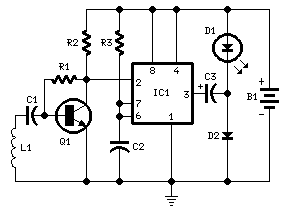Flashes a LED when detecting an incoming call
Powered by one 1.5V cell
Parts:
R1 100K 1/4W Resistor
R2 3K9 1/4W Resistor
R3 1M 1/4W Resistor
C1,C2 100nF 63V Polyester Capacitors
C3 220µF 25V Electrolytic Capacitor
D1 LED Red 10mm. Ultra-bright (see Notes)
D2 1N5819 40V 1A Schottky-barrier Diode (see Notes)
Q1 BC547 45V 100mA NPN Transistor
IC1 7555 or TS555CN CMos Timer IC
L1 Sensor coil (see Notes)
B1 1.5V Battery (AA or AAA cell etc.)
Device purpose:
This circuit was designed to detect when a call is incoming in a cellular phone (even when the calling tone of the device is switched-off) by means of a flashing LED.
The device must be placed a few centimeters from the cellular phone, so its sensor coil L1 can detect the field emitted by the phone receiver during an incoming call.
Circuit operation:
The signal detected by the sensor coil is amplified by transistor Q1 and drives the monostable input pin of IC1. The IC's output voltage is doubled by C2 & D2 in order to drive the high-efficiency ultra-bright LED at a suitable peak-voltage.
Notes:
Stand-by current drawing is less than 200µA, therefore a power on/off switch is unnecessary.
Sensitivity of this circuit depends on the sensor coil type.
L1 can be made by winding 130 to 150 turns of 0.2 mm. enameled wire on a 5 cm. diameter former (e.g. a can). Remove the coil from the former and wind it with insulating tape, thus obtaining a stand-alone coil.
A commercial 10mH miniature inductor, usually sold in the form of a tiny rectangular plastic box, can be used satisfactorily but with lower sensitivity.
IC1 must be a CMos type: only these devices can safely operate at 1.5V supply or less.
Any Schottky-barrier type diode can be used in place of the 1N5819: the BAT46 type is a very good choice.
Author: RED Free Circuit Designs
Email:
Website: http://www.redcircuits.com/

 Audio
Audio







